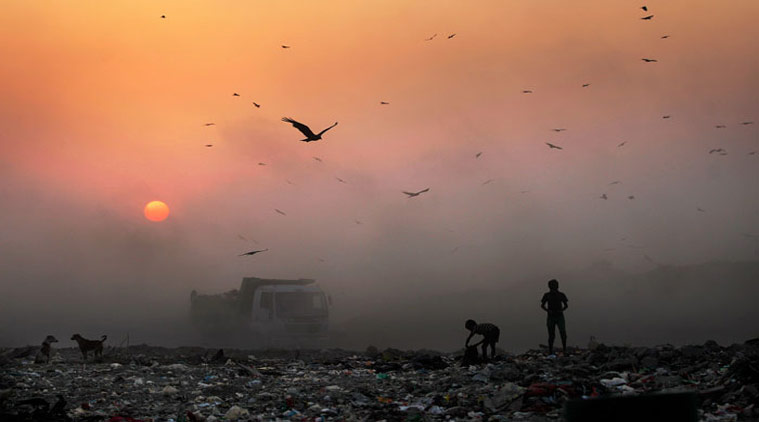Stay updated with the latest - Click here to follow us on Instagram
No disposal mechanism for sanitary pads, ragpickers face threat of infection
Like him, thousands of ragpickers face the threat of allergy, skin rashes, tuberculosis and several other infections, after coming in contact with used sanitary napkins and diapers.
 Ragpickers roam unprotected in these dumpyards.
Ragpickers roam unprotected in these dumpyards.
For 40-year-old Mohammed Ansari who has been working as a ragpicker for ten years, skin infection “is normal” now. He sifts through at least 100 kilograms of waste at the Deonar dumping ground daily, looking for plastic, without masks or gloves. It is not uncommon for him to come across a loosely wrapped polythene bag, unfold it excitedly to acquire the plastic and instead touch a used sanitary napkin accidentally. “Itching is also normal,” he says, nonchalantly.
Like him, thousands of ragpickers face the threat of allergy, skin rashes, tuberculosis and several other infections, after coming in contact with used sanitary napkins and diapers.
[related-post]
Sanitary napkins and diapers make up at least 510 metric tonnes of 8,500 metric tonnes waste generated in the city every day, according to Brihanmumbai Municipal Corporation (BMC) data. But the civic body has no specialised treatment for this kind of waste. Municipal Solid Waste Rules, 2000, has no provision for sanitary waste. This waste can be classified somewhere between domestic and bio-medical waste and the responsibility of discarding it gets tossed to the civic authorities who throw it in the dumpyard, having no other means to handle it. Ragpickers roam unprotected in these dumpyards.
Ansari lives in Padma Nagar, Govandi, and earns over Rs 600 at the risk of touching at least one pad each day. Initially he approached local private clinics for skin rashes, but that soon stopped once the infections became too frequent. “I only go to a clinic if I fall ill now, not for skin allergy,” he said.
According to dermatologist Jitendra Parikh, a lot of women throw away sanitary napkins without properly wrapping them. “The blood becomes host to bacteria like e-coli, streptococci and staphlococci. All this can spread infection. If ragpickers do not wear boots, their feet are prone to catch infection,” he said.
According to experts, chances of HIV virus transmission through sanitary waste is rare, but Shrikala Acharya, doctor and project director at Mumbai District AIDS Control Society, said that protective gear must be worn at all times as preventive measure.
Prakash Sonawane, founder president of Force, an organisation that registers ragpickers, said, “The ragpickers don’t like wearing gloves or masks as the work they’ll finish in one hour will take four hours if they do.” He pointed towards a stack of gloves and masks piling up in a corner, never used by the ragpickers. “It is also harsh that these people have to touch someone’s diaper or sanitary pad. There should be a separate treatment process,” he added.
By definition, “waste containing blood or body fluids” should be regarded as bio-medical waste under the Bio Medical Waste Rules, 1998, and should be processed and treated separately. Sanitary waste is, however, considered municipal waste. Amar Durgule, doctor and sub-divisional head of Mumbai for bio-medical waste at Maharashtra Pollution Control Board (MPCB), said, “MPCB treats hospital generated bio-medical waste. Although it has blood, sanitary napkin comes under domestic waste, and hence, treatment should be looked after by BMC.”
Admitting there was a need to treat this waste separately, Uday Shirurkar, executive engineer at BMC, said that currently BMC had no option but to dump it in landfills. “The BMC vans that collect bio-medical waste from hospitals and nursing homes do not collect this as waste,” he added.
As a start, BMC is in the process of installing two incinerators to treat sanitary napkins in Chembur and Bhandup’s slum areas, but there is no process to segregate used diapers and napkins at source point and transport it to the incinerating unit. Each unit will be able to incinerate 50 to 200 napkins per day.
According to a civic official, slum women will be trained on menstrual hygiene and taught to throw used napkins in a separate bag at community toilets which will then be taken to the incinerator. There is no process of collecting napkins from slumdwellers who have individual toilets. “If napkins have to be treated separately on a large scale, it is important that citizens segregate the waste and hand it over to the kachre-wallah,” the official said.
The incinerator is the size of a mail-box and can be wall-mounted. It treats the napkin at 450 degree Celsius and leaves little ash behind.
Imran Soundekar, service provider for HLL, that has fixed sanitary napkin incinerators in two corporate offices and at Khandala Police training centre, said an incinerator could burn at least 20 napkins in one and half hour. “The concept is still new. Till now, we have not got any calls or seen any tenders for incinerators at BMC,” he said.
tabassum.barnagarwala@expressindia.com






